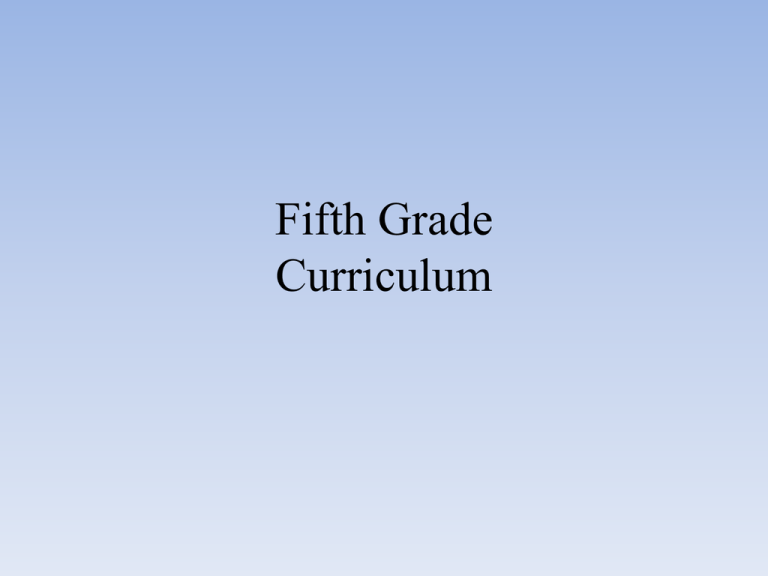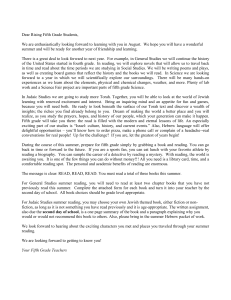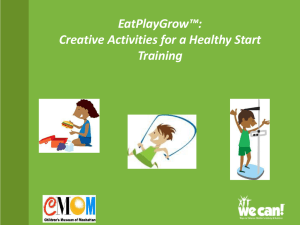Addressed in first Semester
advertisement

Fifth Grade Curriculum Math By the end of fifth grade, our students will be able to… Addressed in first Semester: •Construct arrays for given numbers. •Identifies & list factors of one and two digit numbers. •Applies divisibility rules of 2, 3, 5, and 10. •Define prime and composite numbers. •Solve addition and subtraction number stories. •Demonstrate ability to add, subtract, and multiply whole numbers & decimals. •Classify angles as obtuse, acute, or right. •Demonstrate ability to divide whole numbers. •Convert between improper fractions and mixed numbers. •Produce equivalent fractions. •Formulate common denominators. Addressed in second semester: •Identifies place value form millions to thousandths. •Uses the order of operations. •Plot coordinates on a coordinate grid. •Identifies and differentiates between area and perimeter. •Applies formulas for area of rectangles & parallelograms. •Analyze bar, line, and circle graphs to answer questions. •Focus on basic facts, multi-step multiplication and division. •Understand data landmarks (mean, median, mode, max, minimum, range). Science Fifth grade is an investigation of hands on science topics fostering questioning, prediction, and gathering information as students work through the scientific method. Landforms •Identify landforms. •Recognize effects of weather (erosion) on landforms. Models and Designs •Identify problems and propose solutions •Build a model according to a design Mixtures and Solutions •Know the properties of solids, liquids, and gases. •Compares and contrasts the properties of mixtures and solutions. Health •Physical, social and emotional development. •Making healthy choices. Space •Phases of the moon. •Constellations Environmental Education •Relationships between humans and their environment. •Exploring global and local environmental responsibilities. Social Studies Fifth Grade is an introduction to American History. By the end of the year, our students will have explored the following areas……. Colonization •Colonization of North America Revolutionary War •Cause and effect •Choosing sides •Unification Building a Government •Describe the roles of the branches of our government. •Compare and contrast state and national government. Western Expansion •Louisiana Purchase •Lewis and Clark’s expedition •War of 1812 Civil War •Underground Railroad •Economics Through the use of timelines, maps, globes, graphs, charts and other materials students investigate the historical periods listed above. Reading By the end of 5th grade, our students will be able to… Addressed in first semester: •Create an image based on information provided in a text using visualizing skills. •Utilize self-questioning and teacher questioning to promote active reading through questioning skills. •Construct the meaning of unfamiliar vocabulary using context clues. •Read age-appropriate material aloud with fluency and accuracy. •Identify probable outcomes with evidence from the text using the predicting strategy. •Identify characteristics of realistic fiction text. •Identify text features of non-fiction text. •Compare and contrast across a reading passage. •Identify the causes and effects of events in a story or nonfiction account. •Determine author’s purpose (entertain, inform, or persuade). •Differentiate between fact and opinion. •Prioritize explicit main ideas and details. •Identify characteristics of historical fiction. Addressed in second semester: •Paraphrase and summarize text. •Identify and discuss the elements of plot and setting •Make inferences during reading by using text and schema for support. •Describe what characters are like by what they say and do. •Formulate and defend their viewpoint after making judgments. •Respond to open-ended questions using evidence in text. •Draw conclusions from information in maps, charts, and graphs. •Identify text features of functional text. •Identifies characteristics of a fantasy text. •Draw conclusions based on schema and text. Writing By the end of Fifth grade, our students will be able to …. Write a well developed paragraph including varied sentence structure •Include a topic sentence •Include details and support •Include a concluding sentence Independent use of the writing process •Prewriting with graphic organizers or outlines •Revision •Editing for proper use of grammar and mechanics •Indent and format paragraph properly •Brainstorm ideas •Indent and format paragraphs properly •Maintain focus throughout writing •Write with varied sentence length and type Write an organized 4-5 paragraph expository essay •Include an introduction and strong lead •Write 2-3 body paragraphs •Develop primary/secondary supporting details •Write a conclusion appropriate to the genre •Identify and apply action verbs in writing •Apply subject/verb agreement in writing •Use proper verb tense, past/present/future •Write with varied sentence length and type •Read and “turn a prompt around” to begin an expository essay Specials PE Students will be able to: •Understand all positions/roles on the field. •Demonstrate appropriate force and accuracy in learned game concepts. •Explain the difference between a “GO” “SLOW” or “WHOA” food. For example a GO food is an apple, SLOW food canned fruit and a WHOA food is potato chips. Music The students will be able to: •Read, compose and play more complex rhythm patterns in 2/4, ¾, 4/4. •Sing in two part harmony. •Read short melody using solfege and/or letter names. •Demonstrate tonal memory. •Demonstrate more complex rhythmic memory. Computer •Students will learn and apply skills while using Microsoft Office programs. •Skills taught in Word, PowerPoint and Excel are: Create columns Proper page layout; margins, double spacing, headers and footers Run a slideshow independently using animations and sound Excel basics that include the auto sum function, inserting rows, and columns •Students will become more proficient with keyboarding skills and accuracy with an emphasis on building speed. •Students will be exposed to age appropriate internet safety rules and etiquette with an emphasis on cyber bullying and online communication. •Students will learn appropriate web searching strategies. Art •In the “Sculpture” unit, students will assemble and construct a free standing three-dimensional form that supports its own weight. •In the “Painting” unit, students will utilize and understand proper care of supplies, blending, and mixing colors. •In the “Elements and Principles of Design” unit, students will recognize and supply shape, color, and pattern to balanced compositions. •In the “Drawing” unit, Students will utilize prior knowledge of contour line and observation skills. •In the “Drawing” unit, students will apply their knowledge of special relationships in a composition utilizing foreground, middle ground, and background. Library •Locate materials on library shelves by call number. •Cite sources. •Uses libraries, library resources, the Internet, and other information sources. Comprehensive Resource http://teacherweb.com/IL/KanelandMcDole/MrBerger/sd3l7.aspx






